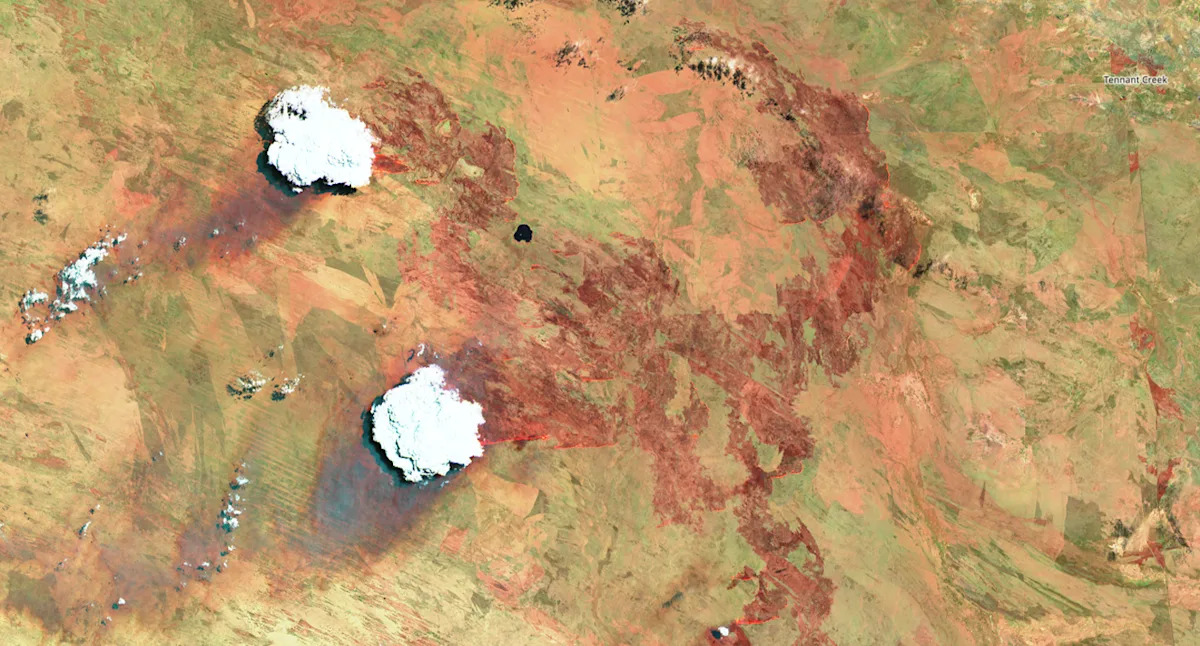In four days, a fire has moved over 100km across the desert, destroying everything in its path. This mega-blaze is so intense that it has been creating its own weather systems, including two large clouds filled with particulate matter that can be seen hovering above Australia’s vast outback.
Charles Darwin University’s Dr Rohan Fisher, an expert in using satellite information to understand complex ecological problems, has been following the fire. Speaking to Yahoo News on Wednesday night, he said it has been “moving quickly” and “every which way”.
“I’ve never seen a fire that big suddenly appear,” he said.
What sparked the mega-blaze?
The two large clouds were created by a mix of humidity and particulate matter from the fires. Underneath, it’s possible to see grey smoke blowing southwest. Earth that’s been scorched by the fires has turned a darker brown, making it possible to track their path through the desert.
Scrutinising images of the desert, Dr Fisher has traced the likely cause of the blaze to four lightning strikes last Saturday, which created separate fires that came together.
Located around 30km west of Tennant Creek in the Northern Territory, it has scorched around 3,000 square kilometres of land. Luckily, earlier fires from 2024 and 2025 have reduced fuel loads in the surrounding area.
There have been dozens of similar occurrences across the Tanami Desert and Great Sandy Desert in Western Australia and the Northern Territory. Because Australia’s deserts are so sparsely populated, few people are aware of their scale.
Over the five days to Wednesday, 6,700 square kilometres had burned across the Northern Territory alone.
“It’s the hottest and driest time of the year, and it also coincides with when we get these lightning strikes. Right now we’re in the very peak of bushfire season for Australia, although if you live down south, you wouldn’t believe it,” he said.

The green line shows the eastward path of the fires between Saturday and Tuesday. Source: European Union, contains modified Copernicus Sentinel data 2025
What blaze is that?
New terms to describe fires have been proposed as blazes become bigger and more dangerous.
Gigafire 100,000 hectares
Terafire 1 million hectares
“People said we’d never need to use terafire, but we’ve had at least one this year, east of Broome. The fires we’re seeing at the moment will be megafires if not gigafires,” Fisher said.
How can the problem be fixed?
Fisher said he finds it “incredibly frustrating” that the focus on fire prevention is often on ignition, rather than managing fuels. “If you don’t create fuel-resistant landscapes, you’re going to have issues,” he said.
Outback terrain has been in decay since European settlement. Invasive foxes and cats have wiped out marsupials from most of the Red Centre, and trade routes and knowledge about waterholes have been lost as Indigenous families were forced out.
“The root cause is the dispossession of Indigenous people of their land, and the change in management across those landscapes,” Fisher said in August.
There are Indigenous rangers in the desert today, using traditional burning patterns to reduce fuel loads. But the area is vast and there are not enough people on the ground to prevent large fires from erupting.
Love Australia’s weird and wonderful environment? 🐊🦘😳 Get our new newsletter showcasing the week’s best stories.


